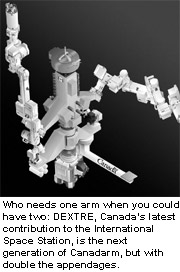DEXTRE is one giant leap in technology
Since the end of the Cold War, space travel and discovery have become less and less mainstream, though countries around the world still spend enormous amounts of money on research every year - most of it, in Canada at least, is focused on one thing.
 “The space industry as a whole in Canada is worth about $2 billion dollars per year,” explained Daniel Lefebvre, an engineer with the CSA. “Now part of the reason for that is because the work we do in robotics, it's really the flagship component that we do and as a result it generally results in getting the other countries investing in us for other space projects.”
“The space industry as a whole in Canada is worth about $2 billion dollars per year,” explained Daniel Lefebvre, an engineer with the CSA. “Now part of the reason for that is because the work we do in robotics, it's really the flagship component that we do and as a result it generally results in getting the other countries investing in us for other space projects.”
Lefebvre is one of the engineers who has been working on Canada's latest contribution the International Space Station, a robotic compliment to the Canadarm 2 called DEXTRE.
“DEXTRE is the next generation of space robot,” explained Lefebvre, who worked on the project as an integration and testing engineer. “Its main purpose in that case is for the maintenance of the space station. Whereas the Canadarm 2 is basically a crane that moves big pieces around the space station, DEXTRE is a dexterous robot who has two arms, and at the end of the two arms, hands that allows it to pick up and manipulate small objects, battery boxes and various other orbital replacement units.”
The robot is quite unique in its design in the fact that its fingers are able to ‘feel' in the human sense of the word.
“The hands have sensors that allow it to ‘feel' where it's going,” Lefebvre continued. “DEXTRE has several cameras that also help keep an eye on what's going on from several perspectives. If you want one from the shoulders, it's there, and also right from the hands themselves.”
In addition to the hands and camera, the robot actually has its own tool belt, which is fitted with a variety of specialty instruments that are commonly used to repair the space station and its individual components. And while Canadarm 2 was fundamental in the construction of the space station in the first place, it was ill-suited to help with the day-to-day maintenance and repairs of some of the smaller instruments. But that doesn't mean that Canadarm 2 is obsolete, in fact DEXTRE was designed to work in tandem with its older counterpart and will be able to move the smaller robot to the various locations around the stations' exterior that need to be repaired.
Like the Canadarm 2, DEXTRE was not only designed, but built in Canada.
“DEXTRE was designed in Canada, though not really in one place,” said Lefebvre. “The lead manufacturer would be MDA [MacDonald, Dettwiler and Associates] which would be in Brampton, Ontario. Then there are subsidiary contractors, there's one in Montreal, Vancouver and a few smaller ones spread all over the place.”
Lefebvre, who has been working on DEXTRE for seven of the 10-years the robot has been in construction, estimates that spread over that extended period about $200 million has been spent on designing, testing and producing the robot. That sum accounts for only 15 per cent of the CSA's annual $300 million budget.
But before the naysayers start complaining about the money that was spent on the robot, and the program in general, Lefebvre wanted to stress that it was the government following through on a promise.
“CSA was basically mandated to do this,” Lefebvre explained. “It was part of an inter-government agreement between Canada, the US and the other partners in the international space station, and this was our contribution to the space station. In exchange we get access to the facility as a whole for research purposes.”
DEXTRE, which will be flown up the space station in March, will be used not only by the astronauts who are already at the station, and who were trained on how to use it in Canada, but by the two Canadian astronauts who will return to the station next year.
Julie Payette is scheduled to visit the ISS in April 2009, a month before Bob Thirsk will travel to the space station aboard a Russian Soyuz capsule.
So next year the International Space Station will have an all-time high in terms of Canadian content, which means nothing but good news for the CSA and the future of the countries space program in general.













